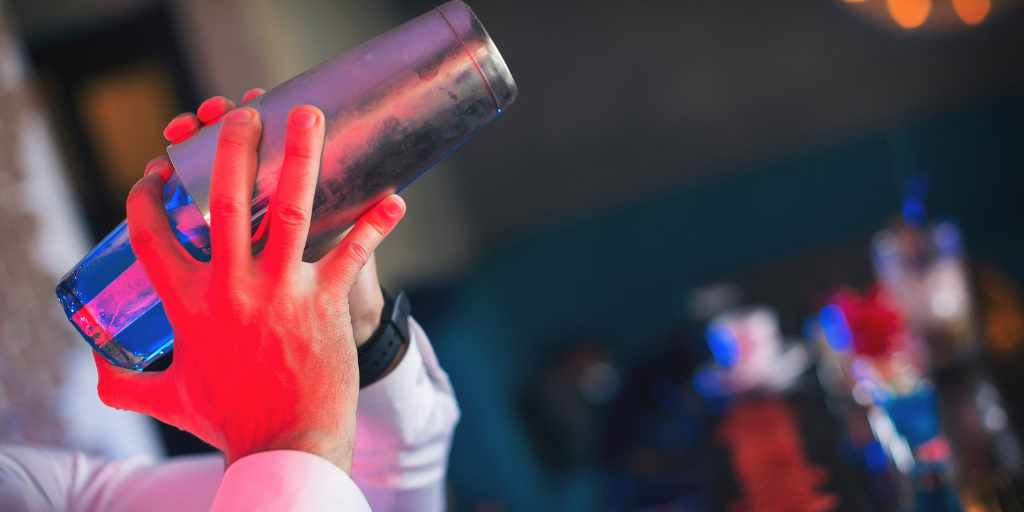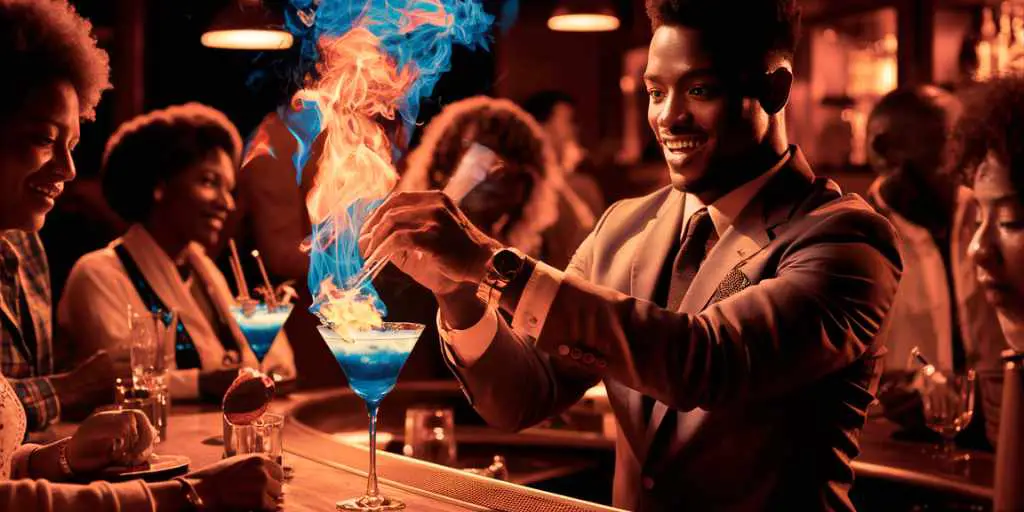Shaking up the cocktail world, introducing the reverse dry shake – a bartending technique that elevates your cocktails to the next level. With its creamy texture and silky consistency, the reverse dry shake has quickly become a staple in mixology.
But it’s not just about the froth. This technique has a rich history dating back to the golden age of cocktails when bartenders sought to perfect their craft and create the ultimate drinking experience.
So, raise your shaker and join us as we dive into the world of reverse dry shaking, discover its origins and learn why this technique is a must-know for any cocktail enthusiast.
The “Standard” Shake
Cocktails are typically shaken in a cocktail shaker, a metal or glass container used to mix drinks. Typically this will either be a Boston Shaker with a mixing glass and a metal tin or a Cobbler Shaker, a three-piece shaker with a built-in strainer and a cap that fits over the top.
To shake a cocktail, the ingredients are placed into the tumbler, the lid is securely fastened, and the shaker is then shaken back and forth with both hands to mix and chill the ingredients. The shaking motion helps to mix the ingredients thoroughly, chill the drink, and dilute it slightly with the added water from the melted ice. The time the cocktail is shaken will depend on the ingredients and desired texture, but it is typically around 10-15 seconds for most cocktails.
After shaking, the cocktail is strained into a glass using the built-in strainer in the lid or a Hawthorn or Julep strainer if you’re using a Boston Shaker. The strainer helps remove ice chips or solids from the drink and ensures a smooth texture. The final step is to garnish the drink as desired and serve it.
What Does Reverse Dry Shake Mean?
A reverse shake is a bartending technique where the ingredients for a cocktail are first shaken with ice and then strained into a shaker without ice. The shaker is then re-shaken vigorously without adding ice, to create a frothy texture. This technique creates a creamy or frothy texture in cocktails and differs from the traditional method of shaking ingredients with ice to chill and dilute the drink. The term “reverse” refers to the order in which the ingredients are shaken, first without ice and then with ice.
What Is the Point of a Dry Shake?
The point of a dry shake is to emulsify the ingredients in a cocktail, resulting in a smoother and frothier texture. A dry shake is performed without ice, meaning the ingredients are not diluted during the cocktail shaking process.
What Is a Dry Shake vs a Reverse Dry Shake?
The main difference between a dry shake and a reverse dry shake is the order in which the ingredients are shaken, with the reverse dry shake starting with ice and the dry shake starting without ice.
A dry shake is a bartending technique where the ingredients for a cocktail are shaken without ice to emulsify and froth the ingredients. This technique creates a creamy or frothy texture in cocktails, such as eggnogs or creamy fruit drinks.
A reverse dry shake is a variation of the dry and wet shake below, where the ingredients are first shaken with ice, then strained into a shaker without ice, and re-shaken vigorously to create a frothy texture. This technique is used to create a smooth and creamy texture in cocktails, and the order in which the ingredients are shaken is reversed from the traditional method of shaking with ice first.
Some cocktails that are commonly made using a dry shake or a reverse dry shake include:
Dry Shake:
- Pisco Sour
- Eggnog
- Ramos Gin Fizz
- White Lady
- Mai Tai
Reverse Dry Shake:
- Piña Colada
- Caipirinha
- Whisky Sour
- Margarita
- Lemon Sour
Not all cocktails require a dry shake or a reverse dry shake, and some cocktails may benefit from a regular shake with ice.
Steps for a Reverse Dry Shake
- Gathering the Ingredients: To start a reverse dry shake, you’ll need to gather all the ingredients for your cocktail, including mixers, syrups, and spirits. Make sure to measure out the ingredients accurately to ensure a balanced flavour.
- Shaking with Ice: Fill a cocktail shaker with ice and add all the ingredients. Shake the ingredients with ice for 10-15 seconds to chill the drink and dilute it slightly.
- Strain into a Shaker Without Ice: Strain the contents of the shaker into a clean shaker, making sure to remove all the ice.
- Re-shaking Without Ice: Re-seal the shaker and shake it vigorously for about 15-20 seconds, ensuring a firm grip. This stage aims to emulsify the ingredients and create a frothy texture.
- Straining and Serving: Strain the contents of the shaker into a chilled glass and garnish as desired. Enjoy your perfectly frothed and creamy cocktail.
Note: The time it takes to achieve the desired frothy texture can vary based on the ingredients and the intensity of the shaking. Shaking the ingredients until they are fully emulsified and the desired texture is achieved is important.
Dry Shaking Questions and Answers
What Cocktails Should Not Be Shaken?
Many cocktails are traditionally stirred rather than shaken due to the type of ingredients and desired texture. Some cocktails should not be shaken: Martini (unless you’re a British spy), Manhattan, Negroni, Old Fashioned, and Sazerac.
How Do You Dry Shake Without Spilling?
Dry shaking can be messy and tricky, but there are some tips that you can follow to minimize the risk of spilling:
- Use a tight-fitting shaker: Ensure that your shaker fits snugly and has a tight seal, as this will reduce the risk of spills and splashes.
- Use a tight grip: Hold the shaker securely and tightly with both hands to minimize the risk of spilling.
- Shake hard and fast: The more you shake the ingredients, the more you incorporate air into the mix, resulting in a thicker and frothier texture. Shake the ingredients as hard and fast as you can without spilling.
- Start with small amounts: When starting out, it’s best to use a small amount of ingredients, as this will make it easier to shake and control the ingredients. You can gradually increase the amount of ingredients as you get more confident.
- Practice makes perfect: Dry shaking takes practice, so don’t be discouraged if you don’t get it right the first time. Keep practising, and you’ll soon develop the technique and confidence you need to make great cocktails.
What Is a Dirty Pour in Bartending?
A dirty pour refers to adding a small amount of leftover ingredients from a previous drink into a new one. The dirty pour technique is often used to create visually appealing cocktails and to add subtle flavour variations to a drink. It can also be used to use up leftover cocktail ingredients and reduce waste.
To perform a dirty pour, a bartender will typically use a jigger or a small measuring cup to control the amount of ingredients being added to the cocktail glass. The bartender will then slowly and carefully pour the leftover ingredients over the back of a bar spoon, creating a layered effect in the glass.
What Is a Dirty Dumping in Bartending?
Dirty dumping refers to directly pouring the entire contents of a cocktail shaker, including the ice, into a glass to be served as is. This method is commonly used in high-volume establishments like clubs and casinos. For certain drinks like margaritas and Mai Tais, dirty dumping can be an intentional choice since these cocktails are typically consumed quickly and will not have enough time to melt.
Can You Overshake a Cocktail?
Yes, you can over-shake a cocktail. Overshaking can result in a diluted and watered-down drink, or it can result in too much foam or froth in the drink, which can be visually unappealing and can also interfere with the flavours. Overshaking can also cause the ice to break down too much, making the drink too cold and dulling the flavours.
Generally, most cocktails should be shaken for around 10-15 seconds.
Conclusion
In conclusion, the reverse dry shake is a versatile and essential bartending technique that can elevate the texture and flavour of your cocktails. With its rich history dating back to the golden age of cocktails, the reverse dry shake continues to be a staple in mixology. Whether you’re looking to create a frothy Piña Colada, a smooth Whisky Sour, or a classic Eggnog, the reverse dry shake is the perfect technique to add a touch of elegance and sophistication to your drinks. So next time you’re behind the bar, give the reverse dry shake a try and impress your friends and guests with your newly acquired mixology skills.
Are you interested in more bar terminology? We have a full article on bartending lingo here.




